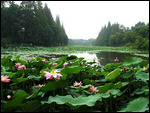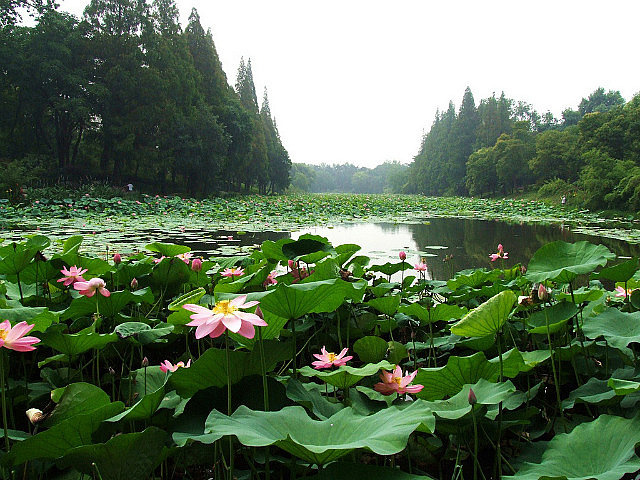Although I grew up in Beijing, I have the most close relatives in Nanjing. This is where both my paternal and maternal "clans" have settled. I have been to Nanjing many times to see relatives but never spent much time sightseeing. Coming from the north, this is the first city south of the Yangtze River, the first city where northerners experience the subtropical, wealthy, and sophisticated "South of Yangtze" region, also known as the "Land of Fish and Rice". Including the mega-city Shanghai, this region has been the economic capital of China for the last nine centuries, its culture considered the most Chinese of all. Named "southern capital", Nanjing was the first capital of the ethnic Chinese Ming dynasty, and the capital of the republic of China from the 1920s to 1949.
We took a 14 hour sleeper train from Qingdao, where Neil and I occupied two beds in a four-bed compartment, sharing with a retired Chinese professor and his grandson who was visiting from Australia. It was a relaxing journey having long chats with the professor into the night. We arrived in Nanjing in early morning, met my aunt and uncle who took us to a fancy restaurant featuring local specialties, especially fish and waterfowl. It was then when I first heard the delicate Nanjing accent of mandarin from the restaurant servers, bringing out my childhood memories.
This time in Nanjing Neil and I still spent the majority of our time in Nanjing visiting with my relatives. Aside from that we went with my uncle Wenxiang to tour Nanjing's major sights. One surprising cultural episode was that the grandmother of one of my two nieces in Nanjing instructed me that my two nieces should call me different titles ("bobo" vs "jiujiu", both translate to "uncle" in English), because one is the child of a male cousin and the other the child of a female cousin. Nanjing was the hottest city we visited on the trip, every day it was steamy like the inside of a sauna. The mighty Yangtze river was formerly a major defensive barrier against invaders from the north. We visited Yuejianglou tower, atop a small hill commanding the southern shore of the river and affording panoramic views. Newly rebuilt according to ancient design, this grand building with many layers of roofs showcases the history of Ming dynasty, and connect with meandering, well-preserved city walls below.
We then went to Zhongshan Hill Scenic Area, whose lushly forested drives were flanked by neat rows of perfectly sculpted French plane trees providing dense shade in the hot summer. Much of the roads follow the intact city walls of Nanjing, which had signs in Chinese saying "I'm six hundred years old, don't touch me". Republican history is exhibited at Linggu Temple, including wax figures of important people involved in overthrowing the Qing dynasty to establish the republic. These were housed in the massive Beamless Hall, a handsome building entirely constructed with brick from the floor all the way to the high vaulted ceiling. In nearby Xiaoling Tomb of the first emperor of Ming dynasty, we followed the long "spirit way" leading to the tomb, guarded by pairs of life size stone animals such as elephants, camels, horses, as well as pairs of larger-than-life stone statues of standing civilian and military officials. These impressive sentinels evoke an eternal stillness and reverence. The largest hall of the tomb was at the end of the path above a huge fortress wall that looked older than its six hundred years of age.
In the evening we took a boat cruise on the Qinhuai River in the old town, starting from Fuzimiao, the Confucius Temple where formerly civil service examinations were held for a thousand years. The river is associated with many literary figures and famous beautiful women, throughout the ages, especially during the "Six dynasties" (~200 to 600 AD) when Nanjing first became capital of the southern half of China. It is quite a spectacle to see on the well-lit shores singing and dancing performed in ancient costumes, while passing ornate tea houses, graceful bridges, sites referencing ancient poets, painters, and musicians. It reminds us of a Disneyland ride.
We also went to Xuanwu Lake Park - a vast lake just outside the city gates - to see the lotus flowers in full bloom. On the way we passed a city gate where each brick on the wall had carvings of Chinese words, recording the county where the brick was made and the overseeing official who bore responsibility for its quality. Some of the carved words were still clearly visible after six hundred years, this means the brick is very hard and erosion-resistant. Tens of thousands of lotus plants filled large ponds on an island in Xuanwu Lake. Countless blooming lotus flowers, many larger than a foot across, painted a jaw-dropping picture of incredible beauty and abundance.
Our last sight in Nanjing was the Nanjing Museum, displaying many fine art objects unearthed or produced locally, from lacquer ware, ceramics, bronze, jade, and silk brocades. The exhibits were displayed and explained well, while its gift shops full of masterful reproductions occupied our attention. Especially notable was a traveling exhibition about Matteo Ricci, a jesuit missionary who came to China in the 16th century and first transmitted classical western knowledge to China. The exhibition contained priceless objects from many international museums, including an original Raphael painting from Italy.

